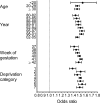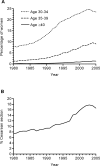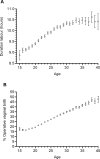The effect of delaying childbirth on primary cesarean section rates
- PMID: 18597550
- PMCID: PMC2443199
- DOI: 10.1371/journal.pmed.0050144
The effect of delaying childbirth on primary cesarean section rates
Abstract
Background: The relationship between population trends in delaying childbirth and rising rates of primary cesarean delivery is unclear. The aims of the present study were (1) to characterize the association between maternal age and the outcome of labor, (2) to determine the proportion of the increase in primary cesarean rates that could be attributed to changes in maternal age distribution, and (3) to determine whether the contractility of uterine smooth muscle (myometrium) varied with maternal age.
Methods and findings: We utilized nationally collected data from Scotland, from 1980 to 2005, and modeled the risk of emergency cesarean section among women delivering a liveborn infant in a cephalic presentation at term. We also studied isolated myometrial strips obtained from 62 women attending for planned cesarean delivery in Cambridge, England, from 2005 to 2007. Among 583,843 eligible nulliparous women, there was a linear increase in the log odds of cesarean delivery with advancing maternal age from 16 y upwards, and this increase was unaffected by adjustment for a range of maternal characteristics (adjusted odds ratio for a 5-y increase 1.49, 95% confidence interval [CI] 1.48-1.51). Increasing maternal age was also associated with a longer duration of labor (0.49 h longer for a 5-y increase in age, 95% CI 0.46-0.51) and an increased risk of operative vaginal birth (adjusted odds ratio for a 5-y increase 1.49, 95% CI 1.48-1.50). Over the period from 1980 to 2005, the cesarean delivery rate among nulliparous women more than doubled and the proportion of women aged 30-34 y increased 3-fold, the proportion aged 35-39 y increased 7-fold, and the proportion aged > or =40 y increased 10-fold. Modeling indicated that if the age distribution had stayed the same over the period of study, 38% of the additional cesarean deliveries would have been avoided. Similar associations were observed in multiparous women. When studied in vitro, increasing maternal age was associated with reduced spontaneous activity and increased likelihood of multiphasic spontaneous myometrial contractions.
Conclusions: Delaying childbirth has significantly contributed to rising rates of intrapartum primary cesarean delivery. The association between increasing maternal age and the risk of intrapartum cesarean delivery is likely to have a biological basis.
Conflict of interest statement
Figures





References
-
- Ecker JL, Frigoletto FD., Jr. Cesarean delivery and the risk-benefit calculus. N Engl J Med. 2007;356:885–888. - PubMed
-
- Guihard P, Blondel B. Trends in risk factors for caesarean sections in France between 1981 and 1995: lessons for reducing the rates in the future. BJOG. 2001;108:48–55. - PubMed
-
- Joseph KS, Young DC, Dodds L, O'Connell CM, Allen VM, et al. Changes in maternal characteristics and obstetric practice and recent increases in primary cesarean delivery. Obstet Gynecol. 2003;102:791–800. - PubMed
-
- Lee SI, Khang YH, Yun S, Jo MW. Rising rates, changing relationships: caesarean section and its correlates in South Korea, 1988–2000. BJOG. 2005;112:810–819. - PubMed
-
- Rietberg CC, Elferink-Stinkens PM, Visser GH. The effect of the Term Breech Trial on medical intervention behaviour and neonatal outcome in The Netherlands: an analysis of 35,453 term breech infants. BJOG. 2005;112:205–209. - PubMed
Publication types
MeSH terms
Grants and funding
LinkOut - more resources
Full Text Sources
Medical

